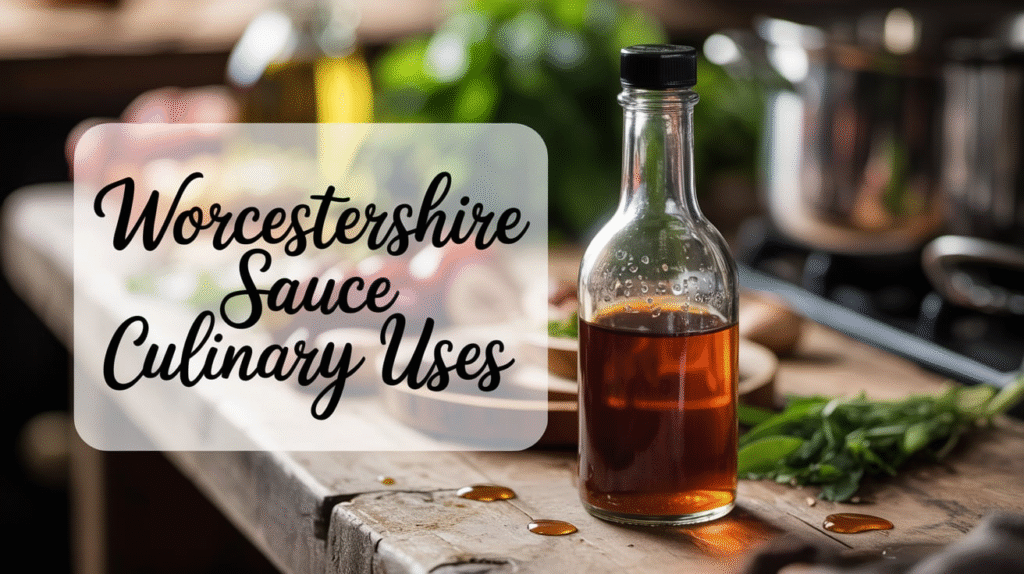Affiliate Disclosure: PantryBrands.co.uk is a participant in the Amazon.co.uk Associates Programme. As an Amazon Associate, we earn from qualifying purchases made through links on this site.
Worcestershire sauce is a bold, umami-rich condiment that elevates countless recipes across British kitchens. Whether it’s splashed into stews, stirred into marinades, or drizzled over your Sunday roast, Worcestershire sauce adds complexity and depth with minimal effort. Thanks to its vinegar base, fermented anchovies, and aromatic spices, this sauce serves as a secret weapon in both traditional and modern cuisine.

Let’s explore the many culinary uses of Worcestershire sauce, including creative ideas and staple recipes that make the most of its bold character.
What Makes Worcestershire Sauce So Versatile?
The secret lies in its complex, balanced flavour profile. It blends tanginess, sweetness, savouriness, and spice—making it suitable for a wide range of dishes.
Flavour Profile Breakdown
Here’s why Worcestershire works in so many dishes:
- Umami boost from fermented anchovies and soy
- Tanginess from vinegar and tamarind
- Sweetness from molasses and sugar
- Warm spice notes from cloves, garlic, and chilli extract
This flavour structure makes it a brilliant complement to both meat and plant-based recipes.
Classic British Dishes That Use Worcestershire Sauce
Many traditional British meals have long included Worcestershire sauce as a key ingredient.
Shepherd’s Pie
A splash of Worcestershire in the mince mixture enhances the meat’s richness and brings out deeper savoury tones.
Welsh Rarebit
This cheese-on-toast dish wouldn’t be complete without a few dashes in the cheese mixture—it adds bite and contrast to the cheddar.
Full English Breakfast
Worcestershire can be added to baked beans or used as a tangy drizzle over fried mushrooms.
Everyday Cooking Uses of Worcestershire Sauce
Beyond the classics, there are many ways to include Worcestershire in your daily meals.
As a Marinade Base
The sauce’s acidity makes it excellent for tenderising proteins while adding flavour.
- Great for marinating beef, lamb, or even mushrooms
- Mix with oil, garlic, and herbs for a quick marinade
In Gravy and Stews
Just a teaspoon or two can make a big difference.
- Enriches onion gravy for sausages and mash
- Deepens beef or vegetable stews, especially slow-cooked meals
Stirred into Sauces
Use it in everything from pasta sauces to curry bases.
- Adds depth to tomato-based sauces
- Boosts the umami in cream or cheese sauces
Uncommon Yet Delicious Pairings
Worcestershire sauce isn’t just for savoury mains—here are some unexpected yet delightful pairings.
Bloody Mary Cocktails
It’s a staple ingredient in this brunch-time drink, adding complexity and zing.
- Enhances tomato juice’s acidity
- Balances out the vodka with savoury notes
Cheese Toasties and Sandwiches
A few drops between slices of cheddar can totally transform the flavour.
- Works especially well with strong cheeses
- Great on toasted sandwiches or paninis
Scrambled Eggs
Just a few drops in your egg mixture can create a richer taste.
- Enhances creaminess without overpowering
- Balances well with herbs like chives or parsley
Vegan and Vegetarian Cooking Applications
Despite the traditional inclusion of anchovies, vegan Worcestershire sauces are widely available now.
Lentil-Based Dishes
It helps mimic meaty depth in vegan shepherd’s pie or bolognese.
- Builds layers of flavour in plant-based dishes
- Combines well with soy sauce for added umami
Mushroom Recipes
Mushrooms and Worcestershire are a match made in heaven.
- Use in mushroom stroganoff, risottos, or pies
- Balances earthiness and adds brightness
Cooking Tips for Best Results
To get the most out of Worcestershire sauce, use it wisely and don’t overdo it.
Dos and Don’ts
- Do: Add near the end of cooking to retain flavour
- Don’t: Add too early to dishes with long cook times, as heat may break down the sauce
- Do: Use sparingly—it’s concentrated
- Don’t: Pair with very sweet dishes unless carefully balanced
Mixing with Other Sauces
Worcestershire combines well with other condiments.
- Blend with ketchup for a tangy burger sauce
- Mix with soy sauce for a rich glaze
FAQs About Worcestershire Sauce Culinary Uses
Here are some questions and answers about Worcestershire sauce’s culinary applications.
What foods pair best with Worcestershire sauce?
Worcestershire pairs best with red meats, mushrooms, eggs, strong cheeses, and tomato-based dishes. It’s also ideal for gravies, stews, and marinades.
Can Worcestershire sauce be used in vegetarian dishes?
Yes, as long as you use a vegan or vegetarian version (which excludes anchovies). It enhances lentils, mushrooms, and other umami-rich vegetables.
How much Worcestershire sauce should I use?
Usually 1–2 teaspoons is enough per dish. It’s strong, so start small and adjust to taste.
Is it okay to use Worcestershire sauce in cold dishes?
Absolutely. It works well in dips, spreads, and salad dressings. Add to hummus or coleslaw for a flavour twist.
Can you cook with Worcestershire sauce on high heat?
It’s best added toward the end of cooking or on moderate heat. Excessive heat can reduce its sharpness and alter the balance of flavours.
